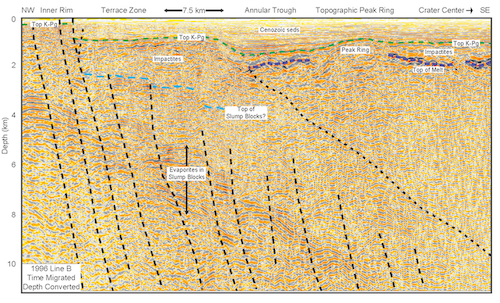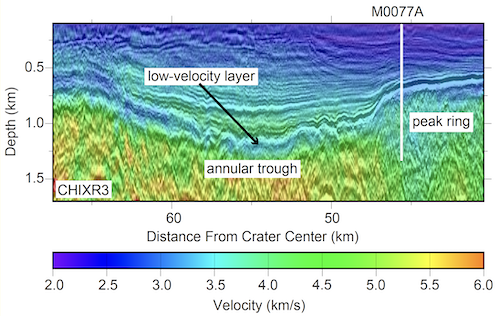Impactite stratigraphy and depositional processes in the Chicxulub and Ries impact structures: What is a crater floor?
- 1Institute for Geophysics, University of Texas at Austin, Austin, Texas, United States of America (sean@ig.utexas.edu)
- 2Department of Geological Sciences, University of Texas at Austin, Austin, Texas, United States of America
- 3Center for Planetary Systems Habitability, University of Texas at Austin, Austin, Texas, United States of America
Introduction: Orbital images of impact crater floors show heterogeneity in texture, relief of central structures, peak rings or terrace zones, and presence or absence of blocks. The absence of the 3rd dimension renders challenges in interpreting the thickness of impactites that fill these craters. Whereas texture in orbital images give clues to emplacement process, terrestrial craters benefit from seismic imaging and scientific drilling.
The Cretaceous-Paleogene (K-Pg, 66 Ma), 200 km Chicxulub impact crater, México, provides the unique opportunity to study crater formation processes related to a large impact [1]. Chicxulub is a multi-ring basin with an intact melt sheet, peak ring, and crater floor (Fig. 1) [1,2]. It is well preserved due to its youth and burial beneath 100s of meters of Cenozoic carbonates [1,2].

Figure 1. Northwest orientied, time migrated seismic line (Line B), which was depth converted using 3D seismic refraction velocity model, crosses from near the crater center to inner ring faults of Chicxulub impact structure showing features with 3x vertical exaggeration. Line shows that impactites represent substantial thicknesses of material burying slump blocks within annular trough, capping the peak ring, and overlying the central melt sheet. Top K-Pg represents top of suevite layer drilled in IODP-ICDP Expedition 364 (see Figure 2). Figure modified from [2].
The 14.9 Ma, 25 km Ries impact crater, Germany, appears to represent a transitional crater form between central peak and peak ring crater with a collapsed central uplift. It has a well-preserved crater floor within the central crater due to burial by lacustrine sediments, but no clear indication of a melt sheet [3].
Insights from Scientific Drilling and New Geophysical Analyses: The International Ocean Discovery Program with co-funding from the International Continental Scientific Drilling Project drilled into the Chicxulub peak ring in 2016 [4]. Hole M0077A (Fig. 2) recovered the uplifted crystalline rocks of the peak ring and the layered deposit that overlies it consisting of impact melt rock overlain by clast-rich impact melt rock and breccia, suevite, and finally sorted suevite with decreasing clast size upsection. These impactites all have a low velocity (~3000 m/s or less) and high porosity (20-40%). Interpretation of this low-velocity sequence is that the lower portion was rapidly deposited onto and perhaps intermixed with impact melt rocks during impactoclastic flows and melt-water interactions. The upper sorted suevite is a resurge deposit in this marine target setting [5].

Figure 2. Seismic reflection Line ChicxR3 within the Chicxulub crater overlain by full waveform inversion generated velocity model. The Chicxulub impact crater peak ring is overlain by a low-velocity zone that can be mapped into the adjacent annular trough which maps to a sorted suevite within IODP-ICDP Exp. 364 Hole M0077A core. White line representing depth reach during drilling (1335 meters below seafloor) where this low velocity layer represented ~90 m thick and was underlain by additional 40 m of more melt rich impactites. Figure modified from [5].
2D, full-waveform tomographic velocity images from the grid of seismic data recorded on a 6-km streamer across the Chicxulub impact crater allowing mapping of these units (Fig. 2). These images show both the lower and upper portions of the low-velocity layer present at Site M0077 thus allowing us to potentially map the thickness of both the resurge deposit and the lower more rapidly deposited layer. Prominent high-velocity zones are also visible that are interpreted to represent intact melt rock (Fig. 2) [2].
In the Ries Crater new high-resolution images highlight layered sequences within the central crater. One interpretation of this package is that it may represent so-called crater suevite penetrated by the Nordlingen 1973 drill core, that we suggest were deposited in impactoclastic flows. In this drill core, suevite is overlain by a thin section of sorted suevite perhaps similar to the upper low velocity zone at Chicxulub. Within the annular trough, the suevite lays unconformably over bunte breccia which was transported inward during crater modification [3].
Impactites and Crater Floor: The Chicxulub crater floor is largely made of the sorted suevite resurge deposit expressed as the upper low velocity zone, which only occasionally is penetrated by a cropping out of deeper impactites. This may reflect the volume of ejecta and impactites formed within the 100 km diameter transient cravity at Chicxulub, that were then uniformly distributed within the final crater due to depth of resurge. The lower more rapidly deposited layer however varies with the greatest thicknesses in the central basin at Chicxulub which may provide insights for Ries.
The layered crater suevite at Ries may be equivalent to this lower unit of melt rich impactites wherein impactoclastic flows incorporate the melt potentially providing an explanation for the lack of an intact melt sheet in this smaller crater. In turn the 2 km thick impactites in the annular trough at Chicxulub (Fig. 1) may represent both ejecta curtain material similar to the bunte breccia at Ries and outward directed melt rock and suevite such that the suevite overlies the ejecta similar to at Ries. The Ries crater floor may have been more heterogeneous with some areas exhibiting blocks of bunte breccia emergent through the suevite and the sorted suevite perhaps not being present throughout the crater.
References: [1] Morgan et al. (2007) Nature, 390, 472-476 [2] Gulick et al. (2013) Rev Geophysics, 51, 31-52 [3] Stöffler et al. (2013) Meteoritics & Planetary Science, 48, 515-589, [4] Morgan J. V. et al. (2016) Science, 354, 878–882 [5] Gulick et al. (2019) Proc Nat Acad Sci.,116, 19342-19351.
How to cite: Gulick, S., Christeson, G., McCall, N., Morgan, J., and Ormö, J.: Impactite stratigraphy and depositional processes in the Chicxulub and Ries impact structures: What is a crater floor? , Europlanet Science Congress 2020, online, 21 September–9 Oct 2020, EPSC2020-928, https://doi.org/10.5194/epsc2020-928, 2020

